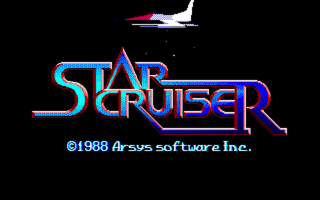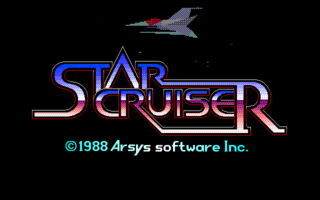Star Cruiser
From NEC Retro
| ||||||||||||||||||||
| Star Cruiser | ||||||||||||||||||||
|---|---|---|---|---|---|---|---|---|---|---|---|---|---|---|---|---|---|---|---|---|
| System(s): PC-8801 mkII SR, PC-9801 M, PC-9801 UV | ||||||||||||||||||||
| Publisher: Arsys Software | ||||||||||||||||||||
| Developer: Arsys Software | ||||||||||||||||||||
| Genre: Shoot-'em-Up, RPG | ||||||||||||||||||||
| Number of players: 1 | ||||||||||||||||||||
| ||||||||||||||||||||
|
This short article is in need of work. You can help NEC Retro by adding to it.
Star Cruiser (スタークルーザー) is a 1988 first-person role-playing shooter, developed by Arsys Software for the PC-8801 mkII SR and PC-9801 M. It was later ported to the Sharp X68000 in 1989 and the Sega Mega Drive in 1990. Ahead of its time, it was a mixture of the action RPG and first-person shooter genres, with the graphics presented in real-time 3D polygon graphics.
No version has been officially released outside Japan.
A sequel, Star Cruiser II, was released for the PC-98 in 1992.
Contents
Overview
Upon its original 1988 release, Star Cruiser was an ambitious and innovative game years ahead of its time. The game's innovations included fully 3D polygon graphics (including nearly all objects, enemies, and backgrounds, with the exception of distant horizons that were pre-rendered), true first-person shooter gameplay (anticipating the likes of Wolfenstein 3D and Doom), gameplay mechanics such as strafing, fusion of the first-person shooter and RPG genres (anticipating the likes of System Shock and Deus Ex), real-time 3D first-person movement (unlike earlier first-person games which were pre-computed), 3D open-world exploration across a large game universe (spanning several star systems), 3D space flight simulator segments for exploring outer space with six degrees of movement (and fighting enemy spacecraft), a crosshair to target enemies (both on ground and in space), and a portable computer built into the player character's power suit that has various uses (such as displaying an automap and radar). The game had a large open-world game universe, allowing the player to explore over 30 planets across four star systems, making it the earliest example of a fully 3D polygon open-world game.
The game also emphasized storytelling, with an epic sci-fi space opera storyline set in the 27th century, plot twists, character dialogues with NPCs (who have their own background stories), anime style dialogue portraits for characters, visual novel style first-preson cutscenes, animated cutscenes rendered using the game's 3D engine, and a chiptune soundtrack composed by Toshiya Yamanaka using FM synthesis (later released as a seperate original soundtrack CD).
History
Star Cruiser runs on a 3D polygon engine previously used by the 1986 Arsys Software role-playing shooter Wibarm, released for the PC-88 and PC-98. While Wibarm only used the 3D engine for exploring indoor environments and presented it in a third-person view, Star Cruiser used the 3D polygon engine for the entire game and presented the view entirely in a first-person view.
Reception
The original home computer releases were critically acclaimed. The PC-88 and Sharp X1 versions won two 1988 awards from Japanese computer magazines, including Best Adventure Game from POPCOM and Best Special Effects from Oh!X.
Physical scans
PC-8801 mkII SR version
PC-9801 M version
PC-9801 UV version
References
Sega Retro has more information related to Star Cruiser
|
| CollapseStar Cruiser games for NEC systems |
|---|
| Star Cruiser (1988) | Star Cruiser II: The Odysseus Project (1993) |
- Genres that need to be looked at
- 1 player games
- PC-8800 series games
- PC-8800 series RPGs
- PC-8800 series shoot-'em-up games
- PC-8801 mkII SR games
- PC-8801 mkII SR RPGs
- PC-8801 mkII SR shoot-'em-up games
- 1988 PC-8801 mkII SR games
- All 1988 games
- JP PC-9801 M games
- JP PC-9801 UV games
- PC-9801 M games
- 1988 PC-9801 M games
- PC-9800 series games
- PC-9800 series RPGs
- PC-9800 series shoot-'em-up games
- PC-9801 UV games
- 1988 PC-9801 UV games
- All games
- Stubs
- Star Cruiser (franchise)





